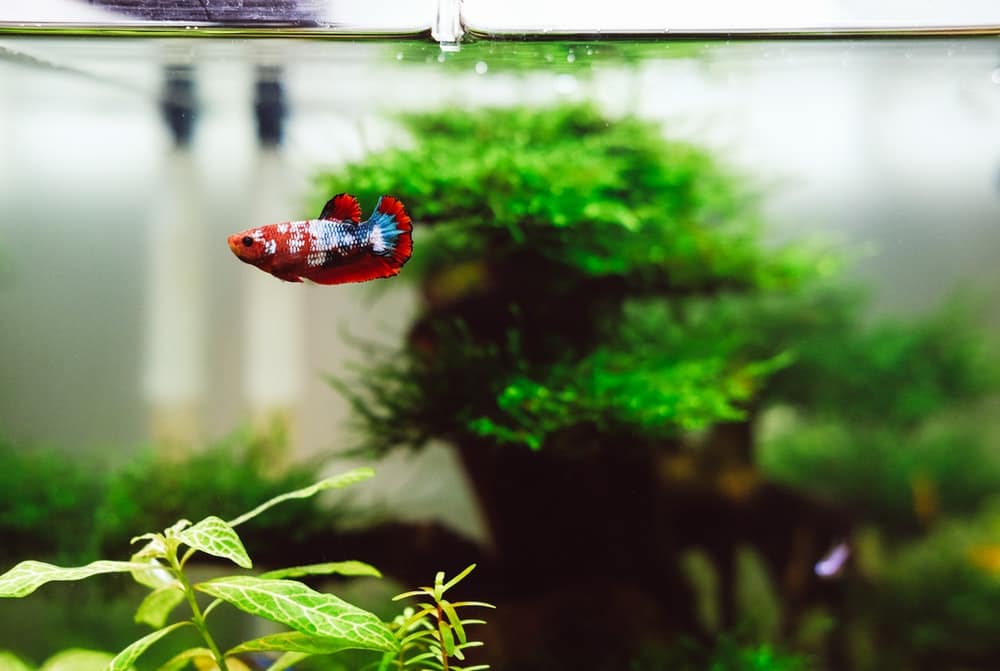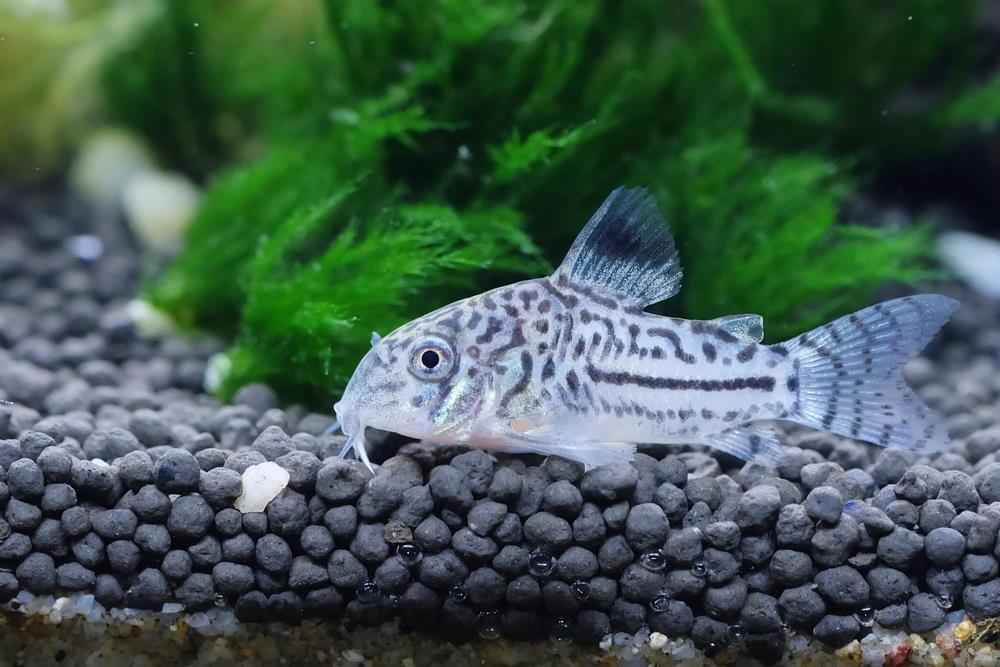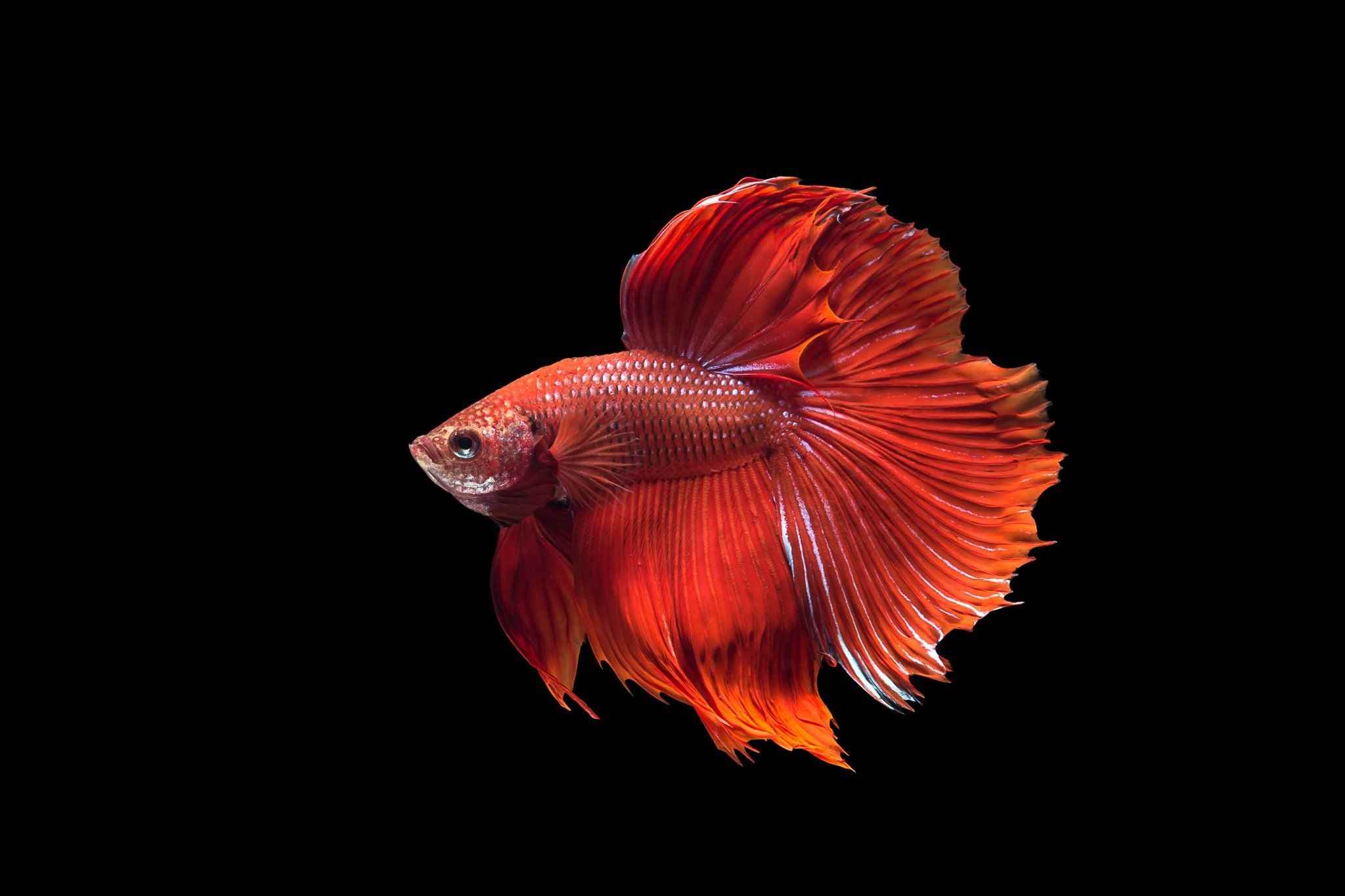Betta fish is a genus of freshwater fish, with the most common one being the Siamese fighting fish. Colloquially known simply as the “Betta”, they originate from Thailand but can also be found in the surrounding countries.
Graceful and colorful, Betta fishes are often seen swimming in beautiful vases inside homes and offices.
They are one of the most popular aquarium fish. Small wonder, considering their vibrant color and low maintenance. Are you looking to buy and keep a Betta? This article will dive deep into the ins and outs of Betta fish.
| Category | Rating |
| Scientific Name: | Betta splendens |
| Common Names: | Betta fish, siamese fighting fish |
| Care Level: | Easy (Beginner Friendly) |
| Temperament: | Peaceful, but don’t keep 2 males together |
| Size: | Up to 3 inches (7 cm) |
| Color: | Wide variety of colors |
| Life Expectancy: | Up to 5 years |
| Diet: | Carnivore |
| Family: | Belontiidae |
| Tank Size: | Minimum 2 Gallons |
| Tank Setup: | Planted tank |
Table of Contents
Overview

We are going to look at the Siamese fighting fish (Betta splendens) in particular, but while generally known as betta, it’s actually one of the 73 species of the Betta genus.
All the Betta species are small, ranging from 2.5 cm to 14 cm, colorful, ray-finned fishes that live in freshwater.
B. splendens, which we’ll refer to as Betta from this point onwards, was first found in the rice paddies, ditches, and flood plains of Southeast Asia. The ever-changing environment there equipped the Bettas with a labyrinth organ.
They can absorb oxygen from moist air as well as the water, so they can survive brief moments out of the water and in low-oxygen tanks.
Types of Betta Fish

You will find hundreds of different Betta fish, especially because they have been cross-bred over the years.
When classifying bettas, people usually look at the tail shape, colors, and pattern. Combine all of these, and no two Betta fish is ever the same!
The tail shape and size can be used to differentiate Bettas. This includes the popular Crowntail with spiky tails, Veiltail whose swooping tail is a dominant trait in breeding, the Plakat with short and rounded tails, or the Halfmoon with a large tail that looks like a half-moon bettas.
Color is also an excellent way to classify Bettas, and this fish has been bred to all the colors of the rainbows! From vibrant blue, red and black, to purple and even white. Some of them have only one color, while others may be a mix of different hues.
In terms of pattern, there are also a huge variety. The most common one is the dragon scale, followed by butterfly, marble, and koi betta.
Many of the exotic patterns you see are the result of selective breeding. They’re usually not found like this in the wild.
Appearance
As we have said, the appearance of Betta fish becomes the way we classify them. But aside from the tail, color and pattern, Bettas are usually small and measure around 6 to 8 cm.
Their natural appearance in nature is fairly neutral: green, brown, and grey bodies with shorter fins. However, Bettas in captivity are more varied in terms of appearance.
Selective breeding has given us brilliant colors and entrancing patterns, as well as large, graceful fins.
Male Betta is usually preferred to adorn freshwater aquariums, as female ones typically have muted colors and shorter fins. Their body mimics the shape of a torpedo and they have an upturned mouth.
Behavior
Generally, Betta fish possesses complex behavior patterns and social interactions. They have shown an ability for associative learning, which makes them interesting subjects for scientists.
Bettas are also quite aggressive and possessive of their territory. When two male Bettas fight, their colors will intensify or their gills will flare out, and this will continue until one of them submits or retreats.
It’s best to house male Bettas separately unless the tank is big enough. While females tend to show similar aggression too, this is usually less frequent and less intense.
Lifespan
In terms of lifespan, the average life of a Betta fish in captivity is around 3 years. Healthy ones can last up to 5 years if you frequently clean the tank and exercise them.
Meanwhile, those in the wild allegedly live shorter than their captured relatives due to less regulated and more dangerous environments.
However, note that Bettas are usually not newly hatched when you purchase them. Males are usually sold at 1 year of age, while females at 6 months.
While there is no evidence, the rumor says that the oldest Betta was nearly ten years old. This is extremely rare and highly impressive. Not to mention that this fish had been raised under strict, well-researched laboratory conditions.
So, don’t expect your Betta fish to live for ten years!
Betta Fish Care Guide

Here are some things to pay attention to if you are planning to keep Bettas as a pet.
Habitat & Tank Requirement
Just like with any fish, the best-nurtured habitat for Bettas is the one that is as close to their natural home.
Since they are a labyrinth species that can get their oxygen from the air, it is okay to keep them in shallow non-aerated waters. This also means that they need to be able to access air from the surface.
However, they thrive better in a larger bowl. This does not mean they cannot survive in a small bowl, but this will require more effort and maintenance on the owner’s part. Avoid placing any plants in the tank too, as Bettas aren’t plant-eaters.
Water Conditions
While a shallow, non-aerated environment is not a problem for Bettas, do not overlook the water condition! It’s best to minimize water movements such as filters and powerheads.
Remember that they are native to tropical areas, so it’s important to keep the water between 75 to 82 F. Colder water can shorten their lifespan, or even kill them.
Meanwhile, the optimal pH is around neutral to slightly acidic (6.8 – 7.5). Suitable tap water can be great, as they contain minerals and nutrients that will benefit your Betta fish. Although, do not use distilled water because they have no minerals in it.

You need to change the water partially at least once a week. Use the water conditioner that was provided when you bought a Betta. In a filtered tank, you only have to change around 20% of the water once a week.
Diet and Feeding
In their natural habitat, this species survives on insects and larvae. They do not eat plants, so Bettas have a shorter alimentary track than fishes who do eat plants.
Their upturned mouth is designed to catch fallen insects, while their digestive system is specifically meant for meat.
If you want to keep your Betta as healthy and happy as possible, try to use mainly live foods. This includes brine shrimp, plankton, Daphnia, glass or bloodworms, and tubifex.
They will also eat these free-dried or frozen. You can also give them flake foods, but make sure to supplement the diet with occasional freeze-dried and live foods.

One thing to note is that a Betta fish may overfeed, which could cause obesity and other health problems. We recommend feeding only small amounts of food at least once a day. Remove any leftover so it doesn’t make the water dirty.
Tank Mate
Bettas will be perfectly fine living along and do not need any tank mates. However, most people prefer their aquarium to be filled with several fishes rather than just one Betta.
Male bettas will most likely clash and fight, so do keep them separate. Males and females are better off in different tanks too, although female Bettas can live together more amicably.
If you want a thriving tank, have at least 5 gallons of water for Bettas and small fish companions. With that said, what are the best tank mates for them?
Perhaps the easiest and most popular choice is a Cory Catfish. They generally get along with any fish species, so housing them with your Betta shouldn’t be a problem.

Mystery snails are also great as they’re docile. While curious Bettas may nip at them, their hard shell will provide enough protection to retreat into.
There are other tank mates to consider for your Betta. This includes the African Dwarf Frog, Glass or Ghost Shrimps, Neon Tetras, Harlequin Rasboras, and Clown Plecos.
Most Common Betta’s Diseases
Yes, fishes can contract diseases, and so can Bettas. The most common ones include columnaris, dropsy, hole in the head, rotting fin or tail, bulging eye, and tumor. There are a variety of causes, from stress, poor water quality, and infections to genetics and even virus or bacteria.
It can be helpful to know how to identify symptoms of these diseases and treat them before it worsens. Identify the physical symptoms or behavioral problems and give them the appropriate treatment.
The best thing to do is identifying and treating the conditions as early as you can. Otherwise, this may cause complications and severe the problem until the Betta is beyond saving.
Breeding Betta Fish
Those who are considering breeding their Bettas should note that the best age to do so is when they are less than a year old. You won’t need any special equipment or overly huge tanks, as they can breed in bubble nests.
Before breeding, condition the fish through a live diet. The tank itself can be small, but it should have around 7.0 of pH and at least 80 F in temperature.
So, what will breeding Bettas look like? First, make sure that there’s a hiding place for the female as their male counterpart may be quite aggressive.
The male will blow a bubble nest when they are ready to spawn. Then, the color of both Bettas will grow more intense as they circle each other in the bubble nest. The male Betta will ‘hug’ the female as she ejects the eggs and they are fertilized.
Pregnant Bettas
A ‘pregnant’ female Betta will have a white patch around the stomach, which is an egg-laying organ. This will look full and bulging, which means she may be ready to spawn. If she does not end up mating with a male Betta, these unfertilized eggs will be expelled but will not hatch.
When the eggs exit the body of the female, the male will catch and place them in a bubble. The male will be the one who tends to the eggs and become aggressive towards her. Therefore, it is best to remove the female after this point.
Egg & Babies
These fertilized eggs inside the bubble nest will hatch in two or three days. The male fish will watch and be ready to catch any eggs that may fall, and these baby Bettas are called “fry”. You will be able to see the tiny fishes hanging from the bubble nest.
For the first 36 hours, they will feed from the yolk sac. During this period, the male will still be protective of the babies. But it’s important to remove him after 2 days as he could eat them once they can swim on their own.
After this, the Bettas will care for themselves and find their own food. In terms of size, the eggs will be no more than 0.03 inches. But these Bettas can grow up to 1.9 inches in only 11 weeks. When they hit seven months, most Bettas will have grown to their maximum size.
Summary
Overall, a Betta fish is a common freshwater aquarium fish. Many will seek them for their mesmerizing colors, unique patterns, and graceful sweeping tails.
Just ensure that male fishes are kept separate and that any tank mates you choose can co-exist with this species.
We personally think any new aquarium owner can keep and care for Bettas, as long as they are diligent and careful. Remember to keep the water warm, clean, and changed regularly, and your Bettas should be happy!






